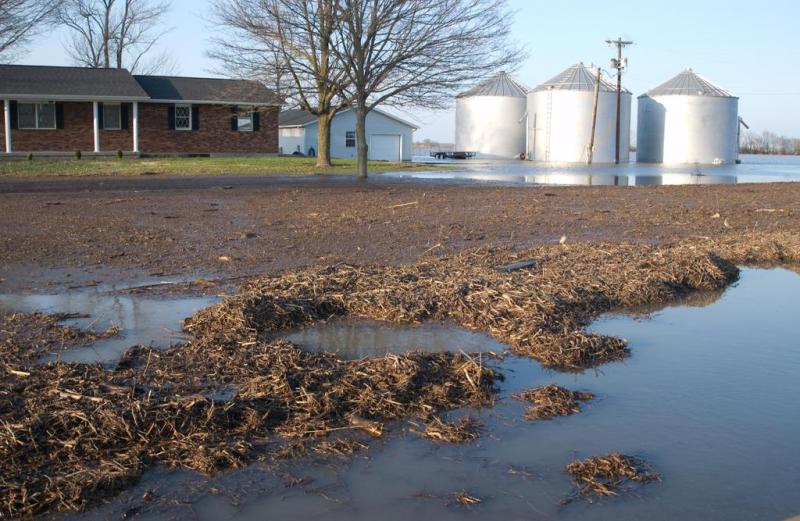Written with contributions by John McMaine, former Griffith Endowed Assistant Professor & SDSU Extension Water Management Engineer.
Depending on its location, domestic well water supplies can oftentimes be negatively impacted during a flood. Floods can impact the water safety as well as the structural, mechanical, and electrical components of a home well through both water damage and by pushing debris against and into the well casing. If the well is currently under flood waters, do not drink water from the well since it may be infected with bacteria. If the flood water has already receded and you’re not sure if the well was impacted, look for sediment, flattened vegetation, and debris to see if the water might have flooded the well.
What to do if a domestic well was flooded.

There are two main considerations for flooded wells: the integrity and function of the well components (casing, pump, electrical) and the quality of the water. If the well was inundated, seek help from a professional electrician to check the electrical components and a professional well pump contractor to check the integrity of the casing and pump. After these components have been checked to be in good working order, run water through an outside spigot and hose until the water runs clear. It is also strongly recommended to test the water before using it for domestic consumption. Well test kits are available at most SDSU Extension county offices and all regional centers. Well test kits can also be ordered directly from the South Dakota Department of Health. You can contact them using the phone number provided on their webpage or fill out your shipping information on the provided form.
How to treat a well for bacteria.
Well contamination is more likely to occur if a well is overtopped. However, even if a well is not inundated, flooding can lead to elevated groundwater levels. Broken septic lines and/or leachate from upgradient livestock operations can cause groundwater cross contamination. It is good practice after a flood to test for bacterial contamination and treat the well if there is possible contamination. If infants and small children will be consuming the water and human or animal waste contamination is suspected, it is recommended to also test for nitrate since excess nitrate can be fatal to infants and small children. Domestic wells can be treated by the homeowner using unscented household bleach to kill harmful bacteria. Use approximately one quart of unscented household bleach for every 50 gallons of well water. The table below shows how many gallons are in every 10 feet of water for three different well diameters. A more extensive table is found at the American Ground Water Trust website.
| - |
4-inch diameter |
6-inch diameter |
8-inch diameter |
|---|---|---|---|
|
10 feet of water |
7 gallons |
15 gallons |
26 gallons |
Source: American Ground Water Trust
After adding the bleach to the well, run an outside hose until you smell bleach (chlorine) in the water coming from the hose. Do NOT run the water into a creek, pond, drainage way that leads to a water body, septic system, or garden area. Then, run cold water in all spigots throughout the home as well as any outbuildings until you smell chlorine. This ensures that the entire system is disinfected, not only the well. Do NOT use the water for a minimum of eight hours after adding bleach and ideally 12-24 hours. Retest the well water for bacteria contamination after 5-10 days.
Additional Resources
- Disinfecting a Domestic Well with Shock Chlorination, New Mexico State University Extension.
- Flood Precautions For Private Water Wells, Minnesota Department of Health.
- Private Well Sampling, South Dakota Department of Agriculture & Natural Resources.
- Shock Chlorination of a Private Well, MSUExtWaterQuality.
- Water Well Disinfection Procedure, American Ground Water Trust.
- Well Disinfection, Minnesota Department of Health.
- What to Do After the Flood, United States EPA.


